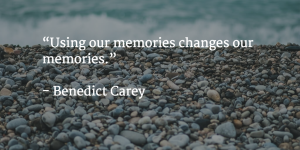1-Sentence-Summary: How We Learn teaches you how your brain creates and recalls memories, what you can do to remember things better and longer, and how you can boost your creativity and improve your gut decisions along the way.
Read in: 4 minutes
Favorite quote from the author:

Audio Summary
Listen to the audio of this summary with a free reading.fm account*:
This book about the science of learning and memory was written by New York Times reporter Benedict Carey and published in 2015. There’s lots to cover, so let’s get straight to it!
These are my 3 learnings from How We Learn:
- Not all memories are created equal.
- Use the spacing effect to remember things long-term.
- Let the Zeigarnik effect boost your memory and creativity.
Time to dig in!
Lesson 1: Not all memories are created equal.
Similar to the way we create habits (remember Hebb’s rule?), memories are also formed when neurons form new connections. The bridge between two neurons is called a synapse, and when these are newly formed, that’s when we remember. When we then recall that memory later, the synapses that belong to it grow thicker, making it easier to recall it in the future.
However, different memories are stored in entirely different parts of the brain. When you meet your new neighbor John, and try to remember his name, that’s a conscious effort at making a memory. These new memories are stored inside the hippocampus of your brain. Then why is it that people with Alzheimer’s can still remember all the old stuff, but forget you just brought them their food 2 minutes ago?
That’s because Alzheimer’s damages the hippocampus, but leaves the neocortex in tact. Old memories that were formed unconsciously, for example going to Disneyland for the first time with your grandparents (personal example) are stored there. It’s the area of the brain that controls and processes our movements, visuals and senses. Memories stored here are much stronger, because each part of your memory is stored in a different section.
For example the taste of the ice-cream my grandma bought me is stored in the synapses of the taste section, while the 1920’s design of the ice-cream parlor lies in the visual processing section. More synapses in more locations means better recall, and that’s why some ancient memories are still so vivid in your brain.
Lesson 2: Use the spacing effect to remember things long-term.
Maybe you met your new neighbor John at a party, then I’m sure you know the scenario. He introduces himself, you shake his hand, and already start repeating his name in your head, so you don’t forget it within 20 seconds. “John, John, John, John…”
Well, you can save it next time, this won’t help. It’ll just make your brain bored. But when you overhear him introducing himself again a few days later to your wife or husband, this will actually thicken the synapses and help you remember his name.
This is called the spacing effect, and has been observed when training animals. If animals are given time between sessions where they have to find their way through a maze, they remember the structure of the maze better two weeks later.
What does this mean for your studying? Simple: Study for the same time, but in multiple sessions, instead of one. So don’t cram in 8 hours of chemistry the day before your exam, study in 4 2-hour sessions and you’ll do much better.
Lesson 3: Let the Zeigarnik effect boost your memory and creativity.
The blink was a bit confusing, because it said interruptions help your memory. What it was talking about (without naming it), was the Zeigarnik effect. It means that your brain opens a loop once you start a project or task, and if you leave it unfinished, your brain will nag you about it until you complete it.
How can this help you learn? Researchers found that when they interrupted participants of a study during tasks, these were the ones they remembered the best later on. Not only will you remember what to do better, if you set aside your studies for a while, but this will also spark your creativity.
As explained in The Upside Of Your Dark Side, your subconscious mind has a much bigger capacity to process data, so taking a break will keep the project in your brain and allow it to think about it in the background.
That’s why you’re best off setting aside a difficult math problem after racking your brain about it for 4 hours straight – the solution will often magically come to you in the shower the next morning.
The Zeigarnik effect is the reason why.
How We Learn Review
This was the perfect set of blinks. It wasn’t too long (8 blinks total), and every single blink had one great point to make. What’s more, all of them were new to me in one way or another. From someone who’s written a massive 11-step study routine post, and created a mini studying course this means a lot. The author really did his homework.
I could’ve easily written down 8 lessons from this summary, I really had to settle here. What’s really cool about How We Learn is that it combats the common advice that you just have to put in your hours on one skill and instead shows you it’s actually better to practice with some space for time off and variety. A good read!
Who would I recommend the How We Learn summary to?
The 35 year old science nerd, who loves to learn all the latest research about how our brain works, the 21 year old college girl, who just forgot someone’s name yesterday, and anyone who’s attending high school or college right now.
Last Updated on July 27, 2022